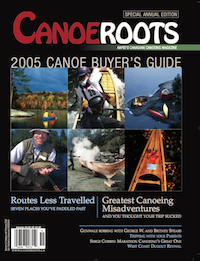We journey down to James Bay again, pulling our three canoes, one paddle stroke at a time, for the 300 kilometres to Moosonee. We travel the seldom-used North French River, catching the last of a wet summer’s high water and then watching the river ebb, day by day, as its life drains away under us. So few whitewater canoeists travel this river because the North French is what the local outfitters call “water critical”. Sandwiched tightly between the Little Abitibi and the Wakwayowkastic rivers, the narrowness of its watershed normally allows canoe travel only just after the snow melts.
There are no signs of anyone having come this way for years, nothing recognizable as a campsite, never a blaze or an axe-cut branch, all the portages are hidden, unused, behind a wall of trees. In a region laced with so many canoeing classics, why explore such a questionable river? Our group of aging paddlers decided long ago never to paddle a river twice and the North French was the only blue line draining into James Bay from the south we hadn’t travelled.
Cold and incessant early summer rains have filled the riverbed completely and we fall into it, early in July, on the very first sunny day in weeks. Even in the first few kilometres, we can see the water dropping. It is possible to see a faint high-water mark etched on the shore grass, now that there are no rains to wash it away. As the days pass, this ever-rising line on the grass urges us on as the earth raises its bony fingers through the surface of the river.
In spite of the nagging reality of the water draining from under our canoes, the North French is not a river to be rushed. In July, the banks are lined with roses, lilies and even orchids, and the black spruce grow to giants, half again as tall as anywhere else so that the upper river winds its way through a deep and shaded spruce canyon.
WHAT IS COMING, AND WHAT IS NOT
Every day moose greet us with long stares that come with their first sighting of humans. We begin to think of this river as an unspoiled garden, our Eden, where everything we see vibrates with health and life. It is a river of great beauty, truly the hidden jewel of all the southern James Bay rivers.
The early spring water levels have left debris high in the trees and stacked bleached driftwood piles to totter over river rock islands. We imagine early season travel at such awesome levels, helped by our trip notes from some long-ago, high-water May descent of the North French’s many falls and ledges.
The notes are more of a planning tool than a guide to the reality of our fading river, but there is a kind of comfort in knowing what is coming around the next blind corner, or more often, what is not. At the more dangerous rapids, described in the trip notes using exclamation marks and heavily underlined cautions, we end up picking precise and delicate lines to thread our way through the rocky puzzle. With so little water, we paddle to the very brink of waterfalls and then portage down the centre of the But the receding spring water path, leaving the sucking, biting bugs back on the unseen portages.
On the ebbing North French, the eddies turn nasty. Normally eddies are somewhere to rest, catch your breath, and look over your shoulder at what’s ahead. But the receding water leaves just-subhorrors from merged blades of granite—boat-rippin horrors from canoeists’ nightmares. Our whole river-running technique is reluctantly turned on its head; instead of finding comfort in eddies, boat safety is now found in the deep water crashing through the waves.
Eventually, low water-swept islands begin to emerge, rocky but blissfully flat, offering somewhere to pitch a tent without the laborious cutting of trees to clear tent sites in the solid wall of jungle on shore. The river opens into the lowlands, flat expanses of shallows with only the vaguest of channels. We walk in the water beside our boats for hours, jumping in and out, pulling and pushing, searching for just enough water to float our weight. Here, the North French is no different than any of the other rivers draining into James Bay. These daylong flatwater stretches, like the bugs, are the price we pay for the days of flowers and rapids behind us.
The North French spills into the Moose River. On the Moose the sky gets bigger, opening into an enormous flatness, and we imagine we can see the ocean as a thin watery horizon line to the north. Behind us lies just what we asked for: another river to add to our lifetime jewel box, a precious adventure in a fleeting window, and another opportunity to travel across this magnificent granite land.
Brian Shields lives and eats well.




